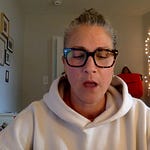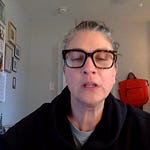Looking Beneath the Surface
On this blog, I often share what I notice—about myself, about others, and about the world around us. Last week, I began speaking more directly about politics. I said that everything is political, and I still stand by that. Because if we peel back the layers of our lives in America, it becomes clear: almost everything is.
Where we live. Where we shop. How we travel. The media we consume…music, television, news, social media. The opportunities available to us, like access to higher education, and even where we can get that education. All of it, at its core, is political.
Showing Up, Even When It Feels Small
When I see what’s happening in Los Angeles and around the country, I try to help…to show up in some way. I share posts on social media. I donate where and when I can. I do what I can, even if it never feels like enough.
Because the kids are watching. My kids are watching. Even when we don’t talk to them directly about what’s going on, they notice. They see how we show up—or how we don’t. For me, perfectionism and fear creep in…and sometimes I still freeze. I feel unsure of how to show up, but if I’m being honest…it’s more of a fear of speaking up. I’m getting better and stronger with this, but it has taken time for me.
Silence in the Classroom
A lot of us struggle to talk about hard things. We avoid difficult conversations, even with the people closest to us. So it makes sense that we often don’t know how to talk to kids about serious issues like racism, violence, and inequality.
Unfortunately, this avoidance is happening in schools, too. Teachers are afraid—understandably—to bring up current events. I remember feeling that fear when I was in the classroom. And now, with the war on Diversity, Equity, and Inclusion (DEI), those conversations have become even more difficult.
Waking Up to Whiteness
We live in a country built on a foundation of violence, white supremacy, patriarchy, and capitalism. I’m not an expert…I’m learning right alongside you. One book that helped me early on is Me & White Supremacy by Layla Saad. It’s a guided journey through the many layers of whiteness and white supremacy, designed specifically for white people who are ready to look inward and do the work.
I live in a predominantly white town—the same one I grew up in. While it has become slightly more diverse over time, the changes are minimal. Living here has made me think even more about how white supremacy operates…not just out there in national headlines, but right here in our neighborhoods, our schools, our conversations, and in our silence.
A Moment That Changed Me
After the murder of George Floyd in 2020, I was talking with my two grade partners. I was teaching fourth grade at the time, and one teacher wondered aloud if we should talk to the kids about what had happened.
Without hesitation, I said no. I thought I was coming from a place of protection—that it wasn’t “appropriate” to bring something so heavy into the classroom.
But our other grade partner didn’t hesitate either. She said she had already talked to her class about it.
I was shocked—and then I felt shame. She was confident, clear, and brave. I was none of those things. I was scared. Scared I’d say the wrong thing. Scared because I had no training in how to have this kind of conversation with children.
It was a turning point for me.
That moment forced me to see something I hadn’t wanted to see: I was that white person. The “nice” white person who believed I wasn’t racist because I was kind and well-meaning. But in that moment, my silence was racism. I had Black students in my classroom, and I said nothing. I didn’t meet them in their reality. I chose my fear over their truth.
Starting the Work Within
That moment became a catalyst—one of many.
I was 40 years old, and for most of my life, I believed that being kind was enough. I didn’t understand that even with good intentions, I was still perpetuating racism—without realizing it because we were living in a white supremacist culture. I thought white supremacy meant the KKK or Nazis. I had no idea it was the very foundation America was built on. But I was finally ready. I wanted to learn. I wanted to change.
I made the choice to do the work on myself. I began reading books and listening to audiobooks. I sought out podcasts and surrounded myself…intentionally…with people committed to evolving, unlearning, and taking accountability. I wanted to be an ally. I wanted to help. But I knew that first, I had to start with me.
I had to crack open.
I had to sit with discomfort, acknowledge the harm of my silence, and take a long, honest look at how white supremacy had shaped me. Only then could I begin to heal. Only then could I show up differently—for my students, for my own kids, and for the world.
It hasn’t been easy. In fact, it’s been really painful at times. But I’m so grateful I began this journey. It’s not a checklist. It’s not something you finish. It’s a lifelong process—a new way of living, seeing, and being.
And I still get it wrong, but I’m no longer using shame or guilt as a crutch. I use it as information. I use it to take me to the next piece I need to uncover. And that’s where intuition comes in. I know what I need to do next intuitively because I’ve learned to trust myself instead of shame myself.
What’s worked for me may not work for you. You have to find your own entry point…your own path. The good news is, there’s no single “right” way or perfect time to begin. What matters is that you begin. That you take action in a way that’s meaningful to you. Because it’s all too easy to slip back into the comfort of the “nice white bubble”. A bubble designed to keep us safe, separate, asleep...and silent.
But not anymore. Not for me. And not for what I want to model for my children.
The Link Between Perfectionism and Silence
When I think about collective healing, I think about individual healing first. I’ve seen time and again how the phrase “when we heal ourselves, we heal others” holds true. That healing ripples outward…to our families, our communities, our country, our world. And in order to heal it, you have to feel it.
To me, the greatest gift we can give each other is the commitment to take care of ourselves…our minds, our bodies, and our souls. But that kind of care requires honesty. Brutal honesty. Because when we’re not honest with ourselves, the same patterns keep repeating. The same feelings show up in new situations. We find ourselves with different people but facing the same issues. Or there’s just a quiet unhappiness lurking in the corners of our lives…or maybe it’s loud and impossible to ignore and we try to pretend it’s not there.
But the truth is, you can’t hide from the truth. None of us can.
Why White People Freeze
One of the biggest barriers I see when it comes to talking about racism—especially for white people—is perfectionism. The idea that if you can’t say it perfectly, you shouldn’t say anything at all. That if you don’t know everything, you can’t show up at all.
But perfectionism isn’t a harmless quirk. It’s a cornerstone of white supremacy culture. It teaches us to avoid mistakes at all costs, to center image and performance over honesty and growth. It tells us that discomfort is dangerous and that failure is shameful.
And so, people freeze. They don’t know what to say. They don’t want to mess up. They’re afraid of being judged, of saying the wrong thing, of being seen as “bad.” So instead of leaning in, they step back—or stay silent.
When we’re not allowed to truly feel, we can’t truly heal. Again…we have to feel it to heal it. We have to feel the discomfort, the guilt, shame and embarrassment in order to heal ourselves.
This “freeze” response is actually a trauma response—our nervous system’s way of trying to protect us from perceived danger. But in this context, it doesn’t protect us…it protects whiteness. And in doing so, it upholds the very systems many of us say we want to dismantle.
Some people avoid these conversations entirely because they don’t believe racism affects them. It’s not part of their daily lives…or so they think. But that’s the blinding nature of privilege. It lets you live inside the bubble without even noticing the bubble exists.
And if this feels triggering—if you’re noticing guilt or shame as you read this—use it as information, not a stopping point. It’s never too late to learn. It’s never too late to change.
What Racism Does to White People, Too
The truth is: racism does affect white people—because white supremacy distorts and disconnects us all. It teaches white people to fear difference, to seek comfort over justice, and to disconnect from their own humanity in order to maintain systems of dominance.
There’s so much I’m still learning and unlearning myself, and I’m excited to keep sharing what’s been meaningful to me…the books, articles, podcasts, websites…all the things that have helped me along the way. We’re in this together.
And listen, if you’re reading this and feeling a little uncomfortable…good. Discomfort isn’t the enemy. In fact, it’s often the door. The key is to move through that discomfort without shame. This work isn’t about guilt. It’s about waking up.
Begin with You
So where do we begin?
Begin with truth. Begin with yourself. If you’re not sure where to start, I recommend Me & White Supremacy by Layla Saad. Read it alone, with a friend, or in a book club. But read it with honesty. Because that’s how healing starts.
Layla Saad’s podcast, Good Ancestor…is EXCELLENT!! The conversations and guests she has are fantastic!
I’m not writing this because I have all the answers. I’m writing because I believe in us. I believe we can face what’s real—and that we can do it together.
Until next time,
Lauren












Share this post